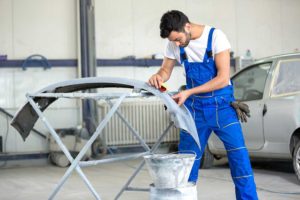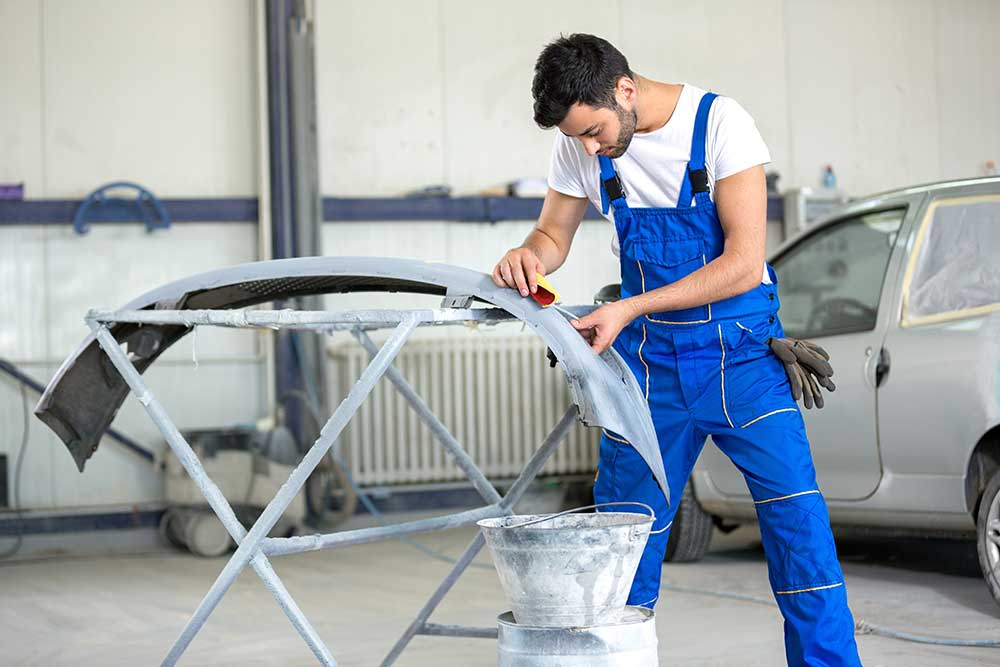Disclaimer: The information on our website is provided for general information purposes only. We make no representations or warranties of any kind, express or implied, about the completeness, accuracy, reliability, suitability or availability with respect to the website or the information contained on our website for any purpose. Any reliance on such information is therefore strictly at your own risk and we are not liable for any damages or losses arising out of or resulting from your reliance on any information contained on our website.
Auto body repairers restore, refinish, and replace vehicle bodies and frames. They inspect car frames for structural damage and assess reparability on damaged parts such as windshields, doors, tires, or the body of the car. They primarily work indoors in auto shops or garages and work can be physically demanding.
Watch a video to learn what an automotive body repairer does:
How to Become an Automotive Body Repairer

Automotive body repairers typically need a combination of a high school diploma and completion of a formal training program in automotive collision repair. This can be earned at a trade school, technical school, or a community college. Classes you would take at trade school include welding, electronics, and repair cost estimation. If attending a trade or technical school program, your program can last anywhere from 6 months to 1 year of studies.
Community colleges generally provide 2-year programs in collision repair and may also offer certifications that cover individual courses so that you can take one class at a time as a part-time student.
Job Description of an Automotive Body Repairer
Automotive repairers duties include inspecting cars for structural damage, reviewing damage reports, preparing cost estimates, and planning work repairs. They remove any damaged body parts, realign car frames, and repair structural damage. Their job includes hammering out or patching dents, dimples, or other minor body damage. These professionals also fit, attach, and weld replacement parts into place. They may also sand, buff, and prime refurbished and repaired surfaces and apply the new finish to restored body parts.
Automotive Body Repairer Career Video Transcript
Whether they’re applying a shiny finish to add sparkle to an old car, or fixing structural damage from a collision, automotive body and related repairers bring damaged vehicles back to nearly-new condition. Auto body repairers restore the structural integrity of car bodies and frames. They use pneumatic tools and plasma cutters to remove damaged parts, and heavy-duty hydraulics for major structural repairs. For some work, they use common hand tools, such as metal files, wrenches, and screwdrivers. Most work in automotive repair and maintenance shops, though many also work at car dealerships. Some are self-employed. The work can be physically demanding— working in cramped positions, often in noisy body shops, these workers commonly suffer cuts and burns, so it’s important they follow safety procedures to avoid serious accidents.
Most automotive body repairers work full time. When shops have a backlog of work to complete, overtime hours are common, including evenings and weekends. Though formal training in auto body repair is preferred, many candidates are hired without it, and learn on the job. Certification from the National Institute for Automotive Service Excellence is a standard credential that often brings higher pay and better job opportunities.
Article Citations
Bureau of Labor Statistics, U.S. Department of Labor, Occupational Outlook Handbook, Automotive Body and Glass Repairers.
National Center for O*NET Development. 49-3021.00. O*NET OnLine.
The career video is in the public domain from the U. S. Department of Labor, Employment and Training Administration.

